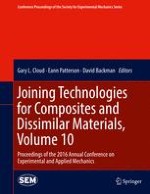2017 | Book
Joining Technologies for Composites and Dissimilar Materials, Volume 10
Proceedings of the 2016 Annual Conference on Experimental and Applied Mechanics
Editors: Gary L. Cloud, Eann Patterson, David Backman
Publisher: Springer International Publishing
Book Series : Conference Proceedings of the Society for Experimental Mechanics Series
